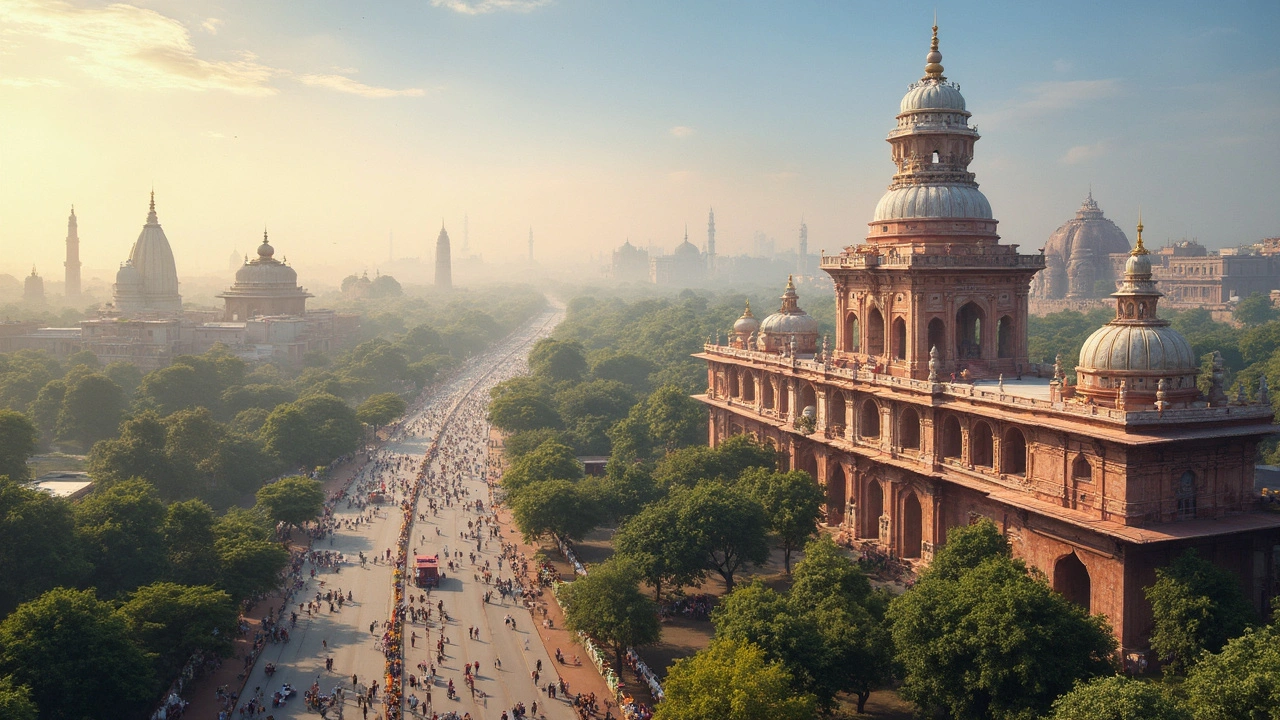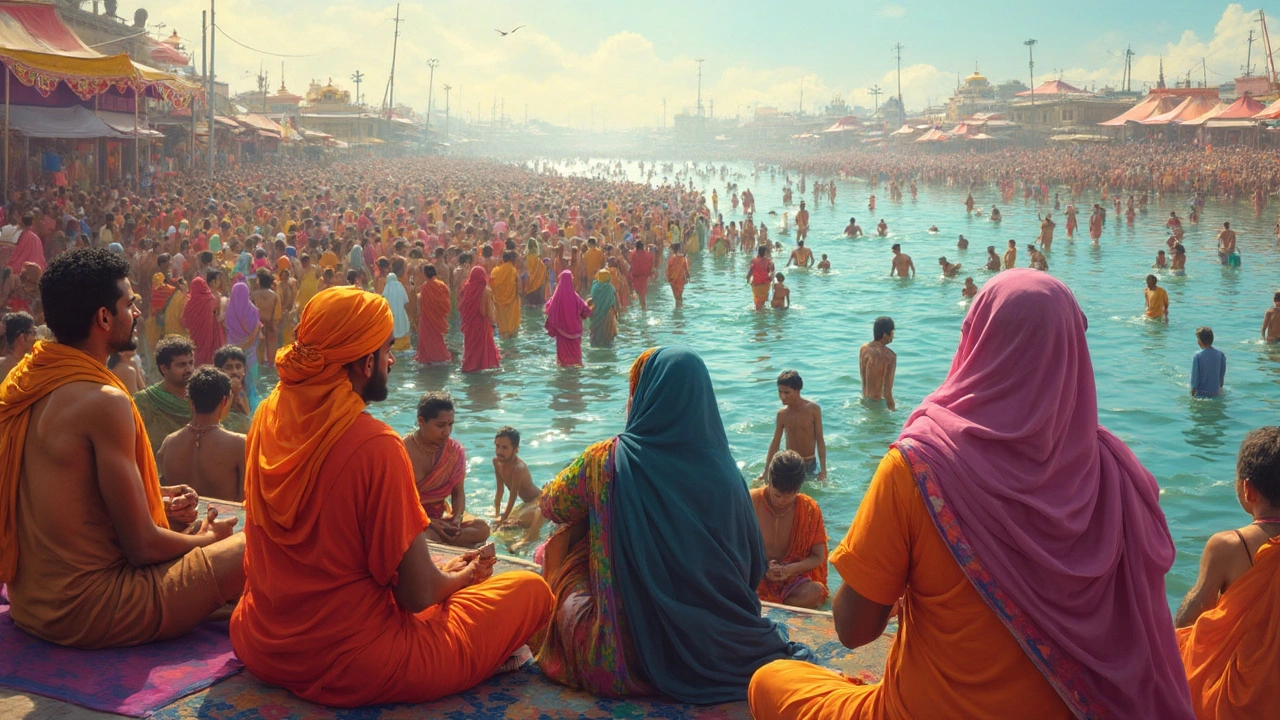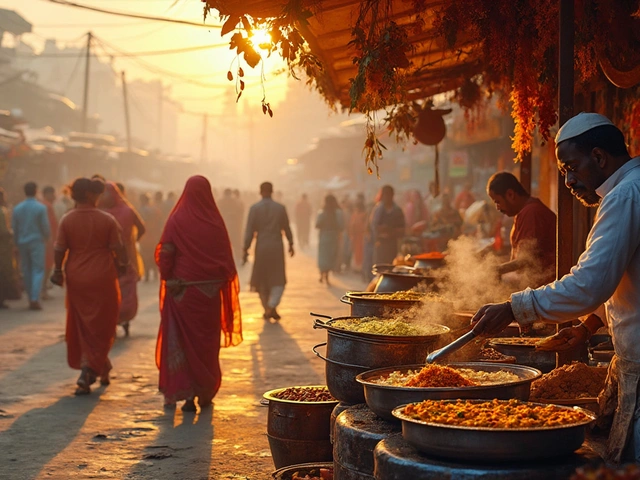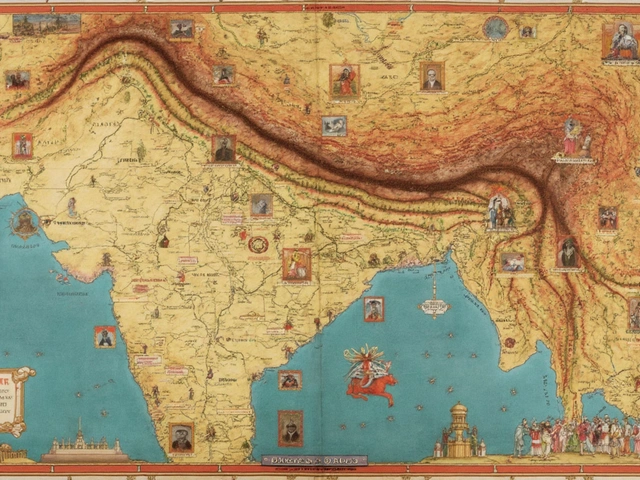Understanding the Religious Heart of Prayagraj
Prayagraj, the city formerly known as Allahabad, stands as a vibrant confluence of cultural and religious currents. This city isn't just a spot on the map; it's often considered one of the holiest cities in India, especially for Hindus. But it's not all about Hinduism here. You’ll find a tapestry of religious practices that influence both the city's character and daily life.
The spiritual vibe kicks in the moment you step onto its bustling streets. Not only is Prayagraj famous for the Kumbh Mela, a massive Hindu pilgrimage gathering, but it also hosts numerous mosques, gurudwaras, and churches. These places aren't only centers of worship; they are repositories of history and legends.
If you’re lucky enough to be visiting, knowing the significance of the religious landmarks can add a layer of depth to your trip. For instance, the Triveni Sangam, the point where the Ganges, Yamuna, and the mythical Saraswati rivers meet, draws millions of pilgrims. It's not just a body of water; it's a spiritual crossroads where rituals take on profound meaning.
- Historical Overview of Prayagraj's Religious Landscape
- Major Religions in Prayagraj
- Key Religious Sites and Their Significance
- Religious Festivals and Traditions
- How Religion Shapes Local Culture
- Travel Tips for Visiting Prayagraj's Religious Sites
Historical Overview of Prayagraj's Religious Landscape
Prayagraj has been a melting pot of religions for centuries, tracing its roots back to ancient times. Its spiritual allure is primarily attributed to its status as a sacred site for Hindus, particularly because of the famed Kumbh Mela and the Triveni Sangam, a confluence of the Ganges, Yamuna, and the mystical Saraswati rivers.
The city's religious mosaic is not just limited to Hinduism. As you delve into its history, you'll discover that Islam also has deep roots here, dating back to the Mughal era. The Mughal emperors, renowned for their architectural marvels, left behind a legacy that includes some magnificent mosques and Islamic educational institutions.
There's a saying by Swami Vivekananda that encapsulates the essence of Prayagraj:
"In religion, Prayagraj holds a unique place as the gathering ground for seekers from all walks of life."His words echo the city's diverse faith landscape.
Key Historical Milestones
- Vedic Time Period: Prayagraj, known as Prayag in ancient scriptures, has been mentioned in the Vedas as a holy place where Brahma, the creator god, performed a great sacrifice.
- Buddhist Influence: Although primarily a Hindu stronghold, the city has historical ties to Buddhism, evidenced by the remnants of Buddhist stupas and relics found in the region.
- Mughal Era: The city, renamed Allahabad, witnessed a cultural renaissance under Akbar, who recognized its strategic and religious importance. He built the Allahabad Fort near the Sangam, a structure that still stands today.
- British Colonial Period: During British rule, Prayagraj was an administrative hub. They retained its religious significance while promoting a more secular governance structure.
Throughout its history, Prayagraj has played host to an eclectic mix of beliefs, each contributing to its rich religious tapestry. The variety you'll see here isn't just historical but very much alive in the daily rhythms and practices of its residents.
Major Religions in Prayagraj
Prayagraj is like a melting pot of various religions, with Hinduism being the most dominant. Hindus make up a significant majority, and the city's identity is deeply rooted in Hindu traditions and customs. However, it's not the only religion that thrives here. A mix of other faiths creates a rich tapestry of practices and beliefs.
Hinduism
As you might guess, Hinduism is central to the cultural and spiritual vibe of Prayagraj. The city is famous for the Kumbh Mela, one of the largest religious gatherings globally, held every 12 years at the Triveni Sangam. Key spots include the Hanuman Mandir and Patalpuri Temple, where mythology and history ride side by side.
Islam
Islam holds a significant place in the religious landscape of Prayagraj. The city houses numerous mosques where the local Muslim community gathers for prayers, festivals, and events. One such notable mosque is the Khusro Bagh, with its stunning architecture attracting visitors.
Christianity
Christianity, though a minority, also has a presence in Prayagraj. Churches such as the All Saints Cathedral, known for its classic British architecture, stand as a testament to this faith's history in the city.
Sikhism
The Sikh community, while smaller, finds its spiritual anchor in several gurudwaras across the city. These sites aren't just places of worship but also centers for community service and education.
Jainism
Jain temples add another layer of spiritual diversity. Jains, though lesser in number, contribute uniquely to the city’s cultural quilt.
| Religion | Community Percentage |
|---|---|
| Hinduism | 71% |
| Islam | 23% |
| Others (Christianity, Sikhism, Jainism, etc.) | 6% |
All these religions co-exist, making Prayagraj a city of not just spiritual importance but also of cultural harmony. This mix enriches its social fabric, providing a sense of community and diversity that’s hard to miss.
Key Religious Sites and Their Significance
Prayagraj stands as a treasure trove of spiritual landmarks. The Prayagraj religion scene is rich with sites that hold immense historical and religious importance.
Triveni Sangam
The Triveni Sangam is arguably the most famous religious site in Prayagraj. It's where the Ganges, Yamuna, and the mythical Saraswati rivers converge. Pilgrims flock here to take a sacred dip, believing it washes away sins. During the Kumbh Mela, the area becomes a massive center of spiritual activity attracting millions.
Allahabad Fort
Next on the list is the Allahabad Fort, a majestic relic that houses the Ashoka Pillar and the revered Patalpuri Temple. Built by Emperor Akbar in 1583, it's not just a fort; it's a spiritual beacon where history and faith intertwine.
All Saints Cathedral
Known locally as Patthar Girja, this gothic-style church provides an insight into the region's colonial past. It’s an architectural masterpiece, and its Sunday sermons are attended by both locals and visitors.
Khusro Bagh
This tranquil garden houses the tomb of Prince Khusro, son of Emperor Jahangir. It's more than just a park; it’s a testament to Mughal architectural brilliance and the significant Islamic influence in Prayagraj.
"Prayagraj is a unique confluence of emperors' tales and sages' stories," said Anil Tiwari, a local historian.
Pilgrimage Insights
When visiting these sites, respect for local customs is crucial. Modest attire is appreciated, especially at religious spots. Walking barefoot is common at many temples, aligning with tradition.
Food and cultural events near these sites offer a taste of local life. Participating can make your visit more immersive and memorable.
| Site | Religion | Region Highlights |
|---|---|---|
| Triveni Sangam | Hinduism | Kumbh Mela Center |
| Allahabad Fort | General | Historical Significance |
| All Saints Cathedral | Christianity | Colonial Architecture |
| Khusro Bagh | Islam | Mughal Heritage |

Religious Festivals and Traditions
Prayagraj is a melting pot of religious festivals and traditions, reflecting its rich culture and spiritual vibe. The city wakes up at the crack of dawn, especially during festival times, with the streets buzzing with activity and colors.
Hindu Festivals
The most prominent event is undoubtedly the Kumbh Mela. Held every 12 years, it attracts millions of pilgrims from around the globe. It’s like the world’s largest spiritual gathering where people take a dip at the Triveni Sangam to cleanse their sins.
Another notable festival is Diwali, the festival of lights. The whole city lights up, and the atmosphere is festive and joyous. Locals decorate their homes with lamps and participate in community events that include music, dance, and of course, the bursting of fireworks.
Islamic Celebrations
Eid is celebrated with much fervor in Prayagraj. Large congregations gather for prayers at the mosques, followed by feasting with family and friends. The streets come alive with people shopping for new clothes and special delicacies like biryani and kebabs.
Other Celebrations
Christmas is celebrated with enthusiasm, especially in areas rich with Christian heritage. Churches are beautifully decorated, with carol singing and services that bring together people from all walks of life.
Sikh communities in the area celebrate Guru Nanak Jayanti with processions. Expect streets full of singing, chanting, and a sense of community as people share free meals, known as langar, with everyone.
| Festival | Month | Significance |
|---|---|---|
| Kumbh Mela | Varies | Spiritual purification |
| Eid | Based on Islamic calendar | End of Ramadan |
| Diwali | October/November | Victory of light over darkness |
| Christmas | December | Birth of Jesus Christ |
These festivals and traditions aren’t just events on a calendar. They’re woven into everyday life in Prayagraj, creating a community that thrives on its strong religious and cultural bonds. When visiting, participating in these celebrations can offer a deeper understanding of what makes this city tick.
How Religion Shapes Local Culture
In Prayagraj, religion isn't just something people practice; it's interwoven into the very fabric of daily life. The presence of various religious communities, including Hindus, Muslims, Sikhs, and Christians, makes for a colorful cultural tapestry that's both rich and varied. This diversity influences everything from festivals to daily routines.
Festivals that Unite
One of the most defining aspects is how religious festivals bring people together. Take the massive celebrations during Diwali and Eid, where the streets transform with lights, decorations, and a flurry of communal gatherings. These events aren't just religious obligations, but rather opportunities for communities to mingle, share meals, and enjoy cultural performances.
Traditions and Daily Life
Religion in Prayagraj strongly influences day-to-day interactions. Morning and evening rituals at home and temples are a common sight, reflecting a rhythm that many residents attune their lives to. On the Muslim side of things, the sound of the Azaan calling for prayer punctuates the day’s activities, serving as a reminder of spiritual duties.
Religious Influence on Art and Cuisine
Local art and food are heavily inspired by religious motifs. Walk through one of the bustling markets, and you'll notice religious symbols engraved in textiles and jewelry. When it comes to food, religious beliefs shape what's cooked and how it's shared, with specific dishes gaining prominence during particular festivals.
Educational and Charity Initiatives
An often less-highlighted aspect is the role religious organizations play in education and charity. Many temples and mosques in Prayagraj run schools and charitable programs, providing free meals and medical aid to the underprivileged. This creates a culture of giving that’s pervasive across the city.
In these and countless other ways, religion in Prayagraj doesn’t just shape culture. It creates a sense of belonging and identity that resonates through every corner of the city.
Travel Tips for Visiting Prayagraj's Religious Sites
Visiting the religious sites in Prayagraj is like diving headfirst into India's cultural melting pot. But, if you want to make the most out of your trip, there are a few things you should keep in mind to ensure a smooth and enriching experience.
Dress Modestly and Respectfully
First things first: the dress code. When you're visiting religious places like temples, mosques, or churches in Prayagraj, make sure to dress modestly. This often means covering your shoulders and knees. Carry a scarf or dupatta if you're visiting the Triveni Sangam, just in case you need to cover up more than expected. It’s always better to respect local traditions.
Plan Your Visit during Festivals
If you're keen on witnessing something truly special, try timing your visit during major festivals like the Kumbh Mela. This once-in-a-lifetime event turns Prayagraj into a vibrant hub of religious fervor and cultural festivities. But remember, it gets crowded, so planning accommodations and transport well in advance is crucial.
Mind the Timings
Religious sites have specific opening hours, and some places may even close in the afternoon. Check timings before you head out, especially for popular sites like the Allahabad Fort or Anand Bhawan. Most temples open early, around sunrise, and this is often the best time to visit to avoid the heat and crowds.
Follow Photography Guidelines
It can be tempting to capture every moment with your camera, but be sure to adhere to the photography guidelines at each site. Some temples and mosques might not allow photography at all, while others have restricted areas. Always ask if you're unsure.
Local Guide: Yay or Nay?
Hiring a local guide can be incredibly helpful, especially if you're a first-time visitor. They can offer insights you won’t find in guidebooks and help you navigate the bustling streets and sites. Plus, they're great for timing your visits to avoid peak crowds.
Navigating Public Transport
Getting around Prayagraj is mostly easy thanks to auto-rickshaws and cycle-rickshaws. For those interested in a more organized exploration, consider renting a car or booking a guided tour which includes religious spots. Always negotiate the fare before you start your journey.
Prayagraj has something for everyone—from peaceful temples to bustling ghats, it’s a city that spiritually and culturally enriches every visitor. Prepare ahead, and you're in for an unforgettable experience!





